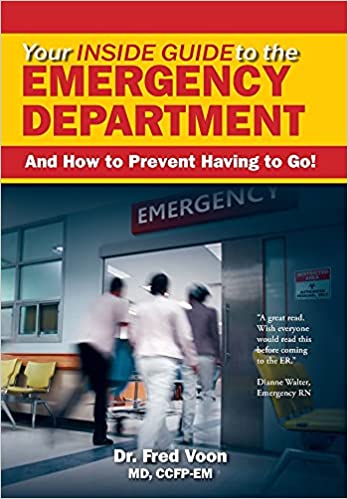 I was asked to review this new book: Your Inside Guide to the Emergency Department and How to Prevent Having to Go, by Fred Voon, MD, a Canadian physician who was residency-trained in Family Practice and Emergency Medicine. It is sort of a home health handbook, short (142 pages), and affordable ($11.76 on Amazon.com with a $9.99 Kindle version).
I was asked to review this new book: Your Inside Guide to the Emergency Department and How to Prevent Having to Go, by Fred Voon, MD, a Canadian physician who was residency-trained in Family Practice and Emergency Medicine. It is sort of a home health handbook, short (142 pages), and affordable ($11.76 on Amazon.com with a $9.99 Kindle version).
Dr. Voon practices in Victoria, BC, and has worked in other parts of Canada and in New Zealand. The book focuses on Canadian EDs, but its information applies to EDs everywhere.
The ER is more appropriately called the ED (for emergency department) since it is more than just one room. Sometimes the decision to go to the ED is a no-brainer, for instance if you have just been struck by a car, lost consciousness, are unable to stand or bear weight, and are bleeding, or if your spouse complains of severe chest pain and collapses and you have to call an ambulance. Sometimes the decision is not so easy. As a doctor, I should presumably be able to tell when a problem warrants a trip to the ED, but several times I have debated whether a worrisome new symptom (my own or a family member’s) was really urgent or whether it would be more appropriate to wait for a doctor’s appointment. I’ve had a lot of strange things happen that resolved on their own without treatment; maybe this was one of them. Should I wait a while?
When I practiced in the Air Force, I frequently had ER duty and I was continually amazed by some of the reasons people gave for seeking emergency care. Sometimes they expected me to treat their dog. Sometimes they came in for a headache and said they hadn’t tried anything for it, not even an aspirin. When I asked why not, they said “Because I thought it would go away”. Or they would bring a child in and not give any history, saying I was the doctor so I should be able to figure it out without them providing any clues. One memorable patient was too embarrassed to tell the female nurse what was wrong. He thought he had gonorrhea, and you should have seen his face when he realized the doctor was a woman too!
In the USA, there are over 138 million ED visits every year. The average wait time to see a doctor is three hours. A substantial percentage of patients will require hospital admission. My note: this varies with age. Around a third of those over the age of 65 get admitted.
Sometimes beds are not available, and patients must wait for hours on a stretcher in the hallway or in the ED. Dr. Voon says don’t expect quiet, privacy, or dignity.
Patients have a lot of misconceptions about what happens in the ED, why they have to keep repeating their story to different people, why they often have to wait so long, or why patients who arrived after them are seen before them. Dr. Voon tries to explain in simple language anyone can understand. He describes the triage process: it’s not first come, first served, but “worst first”. He explains vital signs and common investigations like MRI, CT, EKG, and ultrasound. Doctors will not order a test in the ED unless they think the results will change the treatment plan. Many routine tests can wait for a later appointment.

The book’s author: Dr. Fred Voon
He dispels myths. Calling 911 and arriving by ambulance will not get you seen faster. Treating a fever may improve comfort, but doctors don’t see the fever itself as “the problem”. They want to know what is causing the fever. It was long thought that you shouldn’t take medications before seeing a doctor because it might “mask” appendicitis or interfere with diagnosis; but studies have shown that the exam might even be more accurate after some pain control. Expired drugs are not dangerous, although in a few specific cases they may be less potent; an Dr. Voon says an FDA study of 100 prescription and over-the-counter drugs found that 90% of were “perfectly good to use even 15 years after the expiration date.” My note: Watch out! It’s always best to check. Notable exceptions to this general rule are insulin, nitroglycerine tablets, and tetracycline. Expired tetracycline may cause kidney damage.
He distinguishes between time-sensitive conditions like heart attack or stroke and symptoms that are worrisome to patients but not an emergency (high blood pressure is not an emergency unless it is accompanied by other symptoms; styes and subconjunctival hemorrhage may be alarming to patients, but they are not emergencies). He describes when to suspect appendicitis.
He lists what medications you should have in your home medicine cabinet and describes how to use them appropriately.
He offers practical suggestions such as
-
- Bring an advocate with you to help care for you and help you remember what you are told.
- If you arrive by ambulance, don’t forget footwear, or you might have to go home in paper slippers.
- To cope with a fear of needles, you can try coughing, pinching, or breathing.
- Tips on using eye drops.
- Consider filling out Dr. Voon’s sample medical history form and bringing it with you, along with a list of your current meds.
- Figure out how to best describe your pain to the doctor using OPQRST:
- Onset sudden or gradual
- Precipitating or relieving factors
- Quality: sharp or dull, localized or spread out
- Radiation to other parts of the body
- Severity
- Timing
He covers advance directives, cannabinoid hyperemesis syndrome, the Epley maneuver for vertigo, how to treat nursemaid’s elbow at home, and much, much more.
I thought the information was accurate and the advice was good. The only quibble I had was his inclusion of acupuncture for treatment of low back pain, although he does qualify this by saying “There may be some modest evidence for benefit”. Although he relates the results of scientific studies, he doesn’t provide many references (one exception being for his discussion of drug expiration dates); but this is not a scientific treatise, and considering his intended audience, I don’t see that as a problem.
Appendixes cover the ABC’s of prevention, a list of trustworthy internet sources such as Choosing Wisely, and a glossary of medical terms.
Conclusion: A handy, useful book
This book gets my seal of approval for readability, price, accuracy of information, and practical usefulness. Anyone who is thinking about going to the ED or who wants to avoid going there could benefit from reading it.

